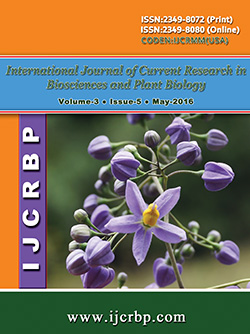 |
Online ISSN : 2349-8080 Issues : 12 per year Publisher : Excellent Publishers Email : editorinchiefijcrbp@gmail.com |
2Department of Microbiology, Dr. MGR Janaki College of Arts & Science for Women, Chennai-600 028, Tamil Nadu, India
Leaf extracts of Cymbopogon citratus (lemon grass) and bulb extracts of Allium sativum (garlic) extracted with various solvents (ethanol, ethyl acetate and aqueous for Cymbopogon citratus, and ethyl acetate chloroform and aqueous for Allium sativum) were evaluated for antidermatophytic activity against Microsporum spp. isolated from different water samples. Out of a total of 60 water samples analysed, 19, 18, 9, 6 and 4 samples showed Microsporum canis, Microsporum gypseum, Microsporum nanum, Microsporum persicolor and Microsporum audouinii respectively. For the present study, Microsporum gypseum and Microsporum canis were used to find out the antidermatophytic activity of the extracts since they were found to be predominant in the water samples analysed. Minimum Inhibitory Concentration (MIC) and Minimal Fungicidal Concentration (MFC) were found out with different solvent extracts of Allium sativum and Cymbopogon citratus and combination of Allium sativum and Cymbopogon citratus extracts which showed best activity when tested individually. Ethyl acetate leaf extract of Cymbopogon citratus and Allium sativum showed the inhibitory activity against Microsporum canis and Microsporum gypseum. Microsporum canis was inhibited by chloroform extract of Allium sativum at a concentration of 250 µg/ml, whereas ethyl acetate and aqueous extract showed inhibition at 125 µg/ml and 500 µg/ml respectively. The ethyl acetate leaf extract of Cymbopogon citratus showed the lowest inhibition concentration of 62.5 µg/ml against Microsporum canis, followed by ethanolic leaf extract (250 µg/ml) and aqueous leaf extract (1000 µg/ml). The combined ethyl acetate extracts of Cymbopogon citratus leaves and Allium sativum bulb recorded the lowest inhibitory concentration of 62.5 µg/ml against Microsporum spp. The combinations of extracts have greater inhibitory activity against Microsporum species tested.
